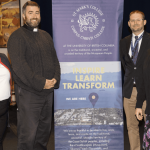Catholic Register publisher Peter Stockland had some uncommon advice for his journalism students attending a new course aimed at developing Catholic journalists.
“You’re there to observe, not to be an activist, but not just to be an observer, either. As you meet your deadline, you will have to faithfully produce for an audience what you observed and learned,” Stockland told more than 20 students attending Telling Truth in Charity: Introduction to Catholic Journalism, a 12-week, online course covering the foundations of Catholic journalism, from the theology of Catholic journalism to newsroom ethics. The program is being offered by the Archdiocese of Toronto’s Saint Monica Institute for Education and Evangelization, the Canadian Catholic News service, and AVIVA Media & Communications.
On the first night of the course, Stockland shed light on the practicalities of melding faith with news reporting, saying effective journalism is a blend of “talent, desire, and learned skills.” He urged aspiring Catholic journalists to hone those skills, since they carry the dual responsibility of delivering both news and the word of Christ.

Stockland began his talk with a real-world experience: his first day on the job for a small-town newspaper and being sent out to cover a fatal school bus crash. As he recounted the story, Stockland highlighted a piece of invaluable advice he received from the staff photographer: “Kid, everybody here knows everyone. You know nothing. Ask questions, but don’t be a (jerk).”
The essence of journalism boils down to equal parts sweat and humility, he said. Reporters should focus on meeting the expectations of readers who know less about the story than the reporter. “You’re there to listen, to observe, and to connect ideas and events” for them, he said.
“Curiosity is essential to journalism,” Stockland said, adding that reporters are often those who early on in life were able to connect and figure things out and were eager to show their knowledge off to others.
“You’re in the world—listening, observing, connecting, and producing,” Stockland said.
The profession comes with its challenges, including the self-imposed feeling of failure when one doesn’t deliver, Stockland said, quoting sportswriter Red Smith’s vivid description of the reporting job: “You just sit at your typewriter and stare until blood forms on your forehead.”
The perks, however, include meeting intriguing people, being the first to find out new things, and having the opportunity to tell them in a compelling way for an audience that sometimes doesn’t know why it should care. Stockland cited Catholic journalist G.K. Chesterton, saying the role of a journalist is to inform people about significant events — like telling them “Lord Jones is dead” when they didn’t even know Lord Jones was alive.
As for the role of faith in journalism, Stockland said Catholic journalism isn’t just about reporting on the Church. It serves as a means of evangelization. “Think of a Venn diagram with two circles: one representing Catholicism and the other journalism. Where they intersect is Christ.”
Terry O’Neil, a veteran reporter and broadcaster who writes for The B.C. Catholic, said he sees firsthand what the work of the Catholic press means to Catholics. “A few weeks ago a fellow parishioner met me after Mass, clasped my shoulders with her hands, looked me in the eyes, and said, ‘Thank you … thank you for the stories you’ve been writing.’”
Stockland similarly shared an account of a reader who wanted to meet over coffee. Seated at the table, the man pulled from his pocket a newspaper clipping of an article Stockland had written years earlier about life and faith. The man told Stockland he had been contemplating ending his life, but after reading the article was able to see his situation in a new light.
B.C. Catholic editor Paul Schratz said it’s getting harder to practise either traditional or Catholic journalism. Canadian Catholic News is responding to the dwindling number of Catholic publications across Canada by building partnerships with Catholic media who are feeling isolated and want to tell stories more effectively for Canadian Catholics.
Schratz encouraged participants to propose freelance ideas to CCN when they complete the course to help tell Canadian stories through a prism of Catholic social teaching. CCN wants to tackle a range of issues, from those that are expected of Catholic media such as euthanasia, abortion, and residential schools, to broader topics like homelessness, drugs, immigration, and human trafficking.
This is the second time Canadian Catholic News has offered an introduction to Catholic journalism course. A smaller version was presented last spring. To sign up for the next offering in the new year, visit bccatholic.ca/catholicjournalism.
Canadian Catholic News launched its new website Tuesday night at canadiancatholicnews.



